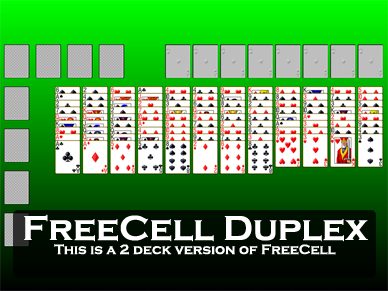
If there are no available cards which can be placed in the foundations, the player must move the cards around on the game board so that more cards with low numbers are directly available.Īs a rule, the player can move only one card at a time - unlike in other solitaire games in which the player can lift an entire stack of cards and move it to a different location. That is, a card can be placed in the foundation only if there is a card already there with a number lower by one and the same suit. The sorted cards are being placed in the foundations in the top-right corner of the game board, beginning with aces. Since then, FreeCell remains famous for the fact that for any randomly shuffled card deal, the game is almost certainly solvable.Īs with most other patience and solitaire games, the player starts with a shuffled deck and must sort the cards from aces to kings for each suit separately. The project lasted almost a year and indicated that only one of the card deals was unsolvable. There was an attempt in 1994 to solve all of the 32,000 card deals.

In that version there were 32,000 different card deals available.
#Free freecell green felt windows#
Although available in earlier version of system Windows, FreeCell gained much of its popularity when it was distributed with Windows 95. Alfille also created a first FreeCell Solitaire video game in 1978. The game was invented by Paul Alfille as a modification of an older game.
#Free freecell green felt free#
The name of the game, FreeCell, comes from the four free cells in the top-left corner of the game board which can be used to temporarily store cards.
#Free freecell green felt full#
There are no redeals.Important shortcut keys Toggle full screen: The top card of the Discard Pile may be played to a Column or to a Foundation. Stock and Discard PileĬards from the Stock are flipped one at a time to the Discard Pile. The exposed card in any Column is available for play to another Column or to a Foundation pile.Įmpty Columns may be filled with any card. For example, within the columns, the only card that can be played onto a 7 of Diamonds would be a 6 of Diamonds. ColumnsĬolumns are built DOWN and in the SAME SUIT. Starting with an Ace and continuing up to the Kings, each Foundation is built UP and in the SAME SUIT. Using two decks, 40 cards are dealt face up to the ten Columns with each column receiving 4 cards. Move all cards to the eight Foundation piles, starting from the Aces and continuing up to the Kings in EACH suit. But we are looking into providing other variations since it is so popular. Although there are many variations of Forty Thieves, Solitaire Network is happy to provide this most common version of the game. Although only 5% of Solitaire Network plays result in a win, we think that with careful forethought and close attention to what cards have already been seen, and yet to be seen, that the win rate would be somewhere between 15 and 20%.įorty Thieves gets its name from the fact that there are 40 cards dealt to the layout at the start of the game - each card being a thief that wants to prevent you from winning - hence there are 40 thieves that are out to stop you. He certainly knows a thing or two about solitaire.įorty Thieves will require your concentration and a considerable amount of attention to play it well. In David Parlett's History of Patience, the argument is made that the facts may have been misinterpreted.

While many of those facts are true, there is some controversy as to whether Napoleon was playing this particular game, or for that matter any kind of solitaire game at all. Legend has it, Napoleon was an avid card and game player and supposedly played this game while exiled on the barren wind-swept island of Saint Helena after losing the battle of Waterloo to the British in 1815. In times past it has been known by a variety of names: Big Forty, Napoleon at Saint Helena, Roosevelt at San Juan, and Le Cadran. The game is most likely of French origin. Forty Thieves (a.k.a "40 Thieves") is a challenging game of skill that has become quite popular in recent years.


 0 kommentar(er)
0 kommentar(er)
